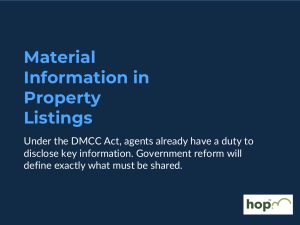By Sally Holdway, Co-Founder – Homeowner’s Passport.
As the conversation around material information evolves, much of the focus has understandably been on compliance and process. But the more data we surface through upfront disclosure, the more we’re seeing a clearer picture of the legal and practical issues that shape every property transaction.
And if you’re a lawyer or estate agent, it’s time to start paying attention—because this data isn’t just informative. It’s actionable.
What We’re Seeing in the Numbers
At Homeowner’s Passport, we’ve processed a significant and growing volume of conveyancing-grade material information. And certain patterns are emerging again and again across properties of all types.
Here are just a few of the standout figures from our dataset:
-
50% of properties include a restrictive covenant
-
15% contain a non-charge or non-forma restriction
-
16% are affected by a right or obligation (often with financial implications)
-
69% have had some form of building work
-
12% show a boundary mismatch between plan and reality
-
4% involve a history of flooding
-
22% are not connected to mains drainage as expected
These aren’t obscure edge cases. They’re material factors that shape title advice, lender requirements, and deal timelines.
Why This Matters to Legal Professionals
For lawyers, these aren’t just data points—they’re early indicators of transaction risk and workflow opportunity.
-
Restrictive covenants often require upfront decisions: will you advise on indemnity insurance now, or let it stall the exchange in 6 weeks?
-
Restrictions on title frequently involve third parties—freeholders, management companies, mortgagees—who need time to respond.
-
Drainage and rights are increasingly being scrutinized in environmental and lender due diligence.
-
And building works? Nearly 7 in 10 properties have them. Whether or not they’re properly certified is one of the most frequent causes of post-offer queries.
🛠 Using Material Information Proactively
What we’re learning is that this isn’t just about speed—it’s about proactive legal strategy. When lawyers get visibility on these issues before the offer, they can:
-
Clarify the client’s risk position
-
Instruct indemnities early
-
Begin fixing title issues pre-contract
-
Avoid back-and-forth delays in mid-transaction
When estate agents and lawyers work together on this data, it changes the shape of the transaction. Deals stop falling through at week 14. Clients stop wondering what’s taking so long. And conveyancers can focus on legal advice, not admin triage.
The Opportunity Ahead
Material information is doing more than ticking regulatory boxes. It’s giving us a powerful lens on what really holds transactions back—and what we can do about it.
The data isn’t just noise. It’s insight.
And with the right tools, we can act on it.



